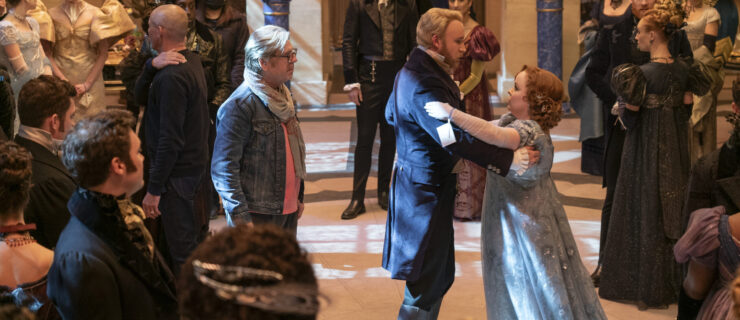"Oklahoma!" Is Back on Broadway—in a Brand-New State
You may think you know Oklahoma!, the classic Rodgers and Hammerstein musical that made history when it first opened in 1943 and is best known for Agnes de Mille’s groundbreaking dream ballet. But the latest Broadway iteration of the musical isn’t your average trip to the frontier. Opening April 7, the revival features new choreography by Mark Morris alum John Heginbotham, and swaps the traditional windswept-prairie set and full orchestra for an intimate, minimalistic staging and a bluegrass band. Coming fresh off an acclaimed run at St. Ann’s Warehouse in Brooklyn, the daring, unconventional production is sure to turn heads when it begins previews on Broadway tonight. Dance Spirit caught up with Heginbotham to get all the details on the dancing, and what it was like choreographing his first Broadway show.
Dance Spirit
: What got you interested in Oklahoma!?
John Heginbotham: I grew up with musical theater. It was my introduction to entertainment and to the performing arts, and Oklahoma! was one of the first movie musicals that I ever saw. There was always a soundtrack playing in my house, and we’d watch tons of movies. I was extremely excited to be asked to be part of this version.
 Rebecca Naomi Jones (left) as Laurey with Damon Daunno (right) as Curly in last year’s run at St. Ann’s Warehouse (Teddy Wolff, courtesy DKC/O&M)
Rebecca Naomi Jones (left) as Laurey with Damon Daunno (right) as Curly in last year’s run at St. Ann’s Warehouse (Teddy Wolff, courtesy DKC/O&M)
DS
: What’s the choreography like?
JH: There’s quite a bit of dancing in the revival, but a lot of it’s based on social dancing: two-steps and country swing, things that you might see at a community center in the South. The beauty is that everybody brings their personality to the moves. That’s how it would be if you were at a dance party; everybody kind of dances in their own way. The one exception to that is the dream ballet, which is performed primarily by a single performer, Gabrielle Hamilton.
DS
: How did you approach the dream ballet?
JH: Our way into the dream ballet is through this one performer. She’s purposefully ambiguous, and the intention is that the audience is free to associate and interpret what they’re seeing. The vocabulary features quotes from Agnes de Mille and her original dream ballet, and images that were previously mundane in the show presented in much more sinister or fantastical ways. It’s a surreal sequence that for me follows dream logic. I’m hoping it’s going to feel startling, but also tender and lovely.
DS
: Was it intimidating to choreograph your own version of a piece so many people know and love?
JH: Yes, 100 percent. Agnes de Mille broke serious new ground with the dream ballet, and she made a strong case for what the place of it should be in the show. We’re doing something that’s really different, but I think it’s true to her intention—’What is going to advance the plot, or the momentum, or the arc of the show?’ I would say that if somebody pays a lot of money expecting to see an arabesque, they will not be very happy.
A version of this story appeared in the April 2019 issue of
Dance Spirit with the title “Oklahoma! Heads to Broadway—in a Brand-New State.”




